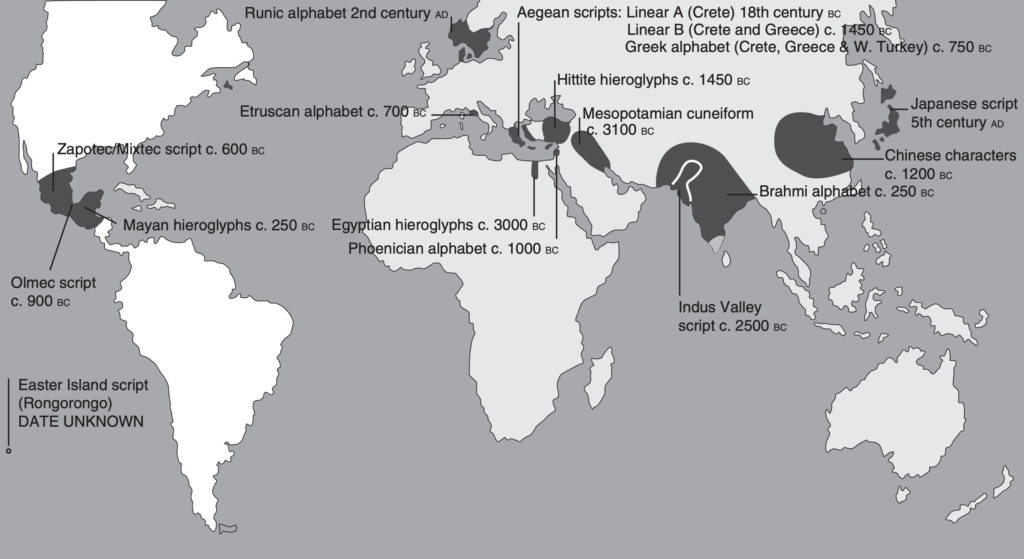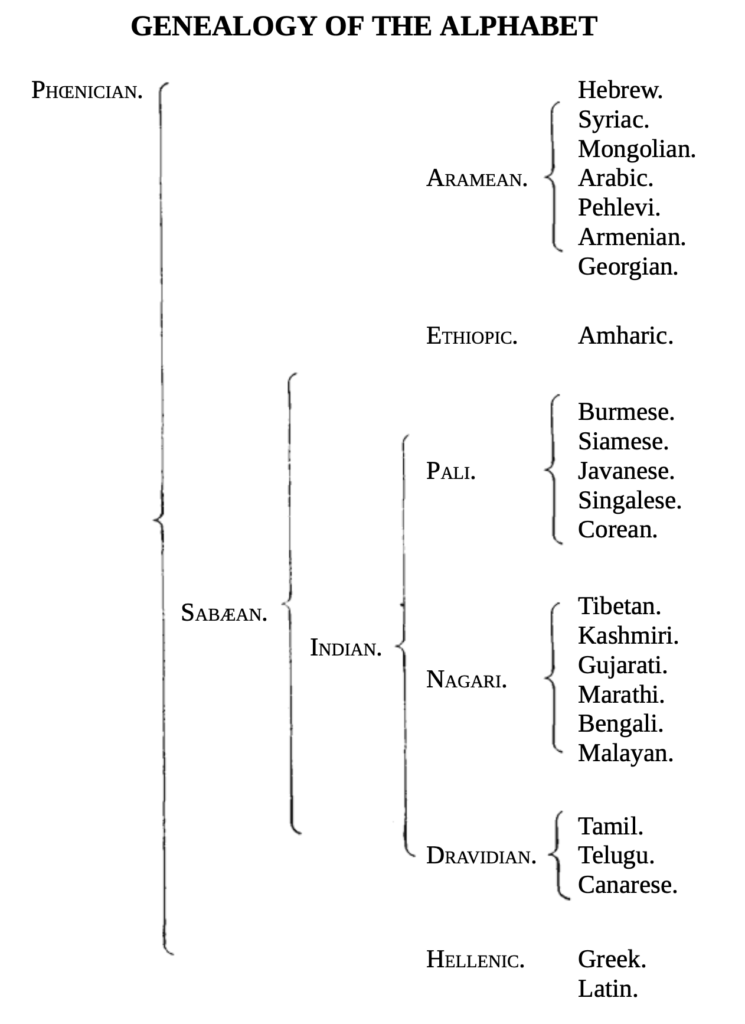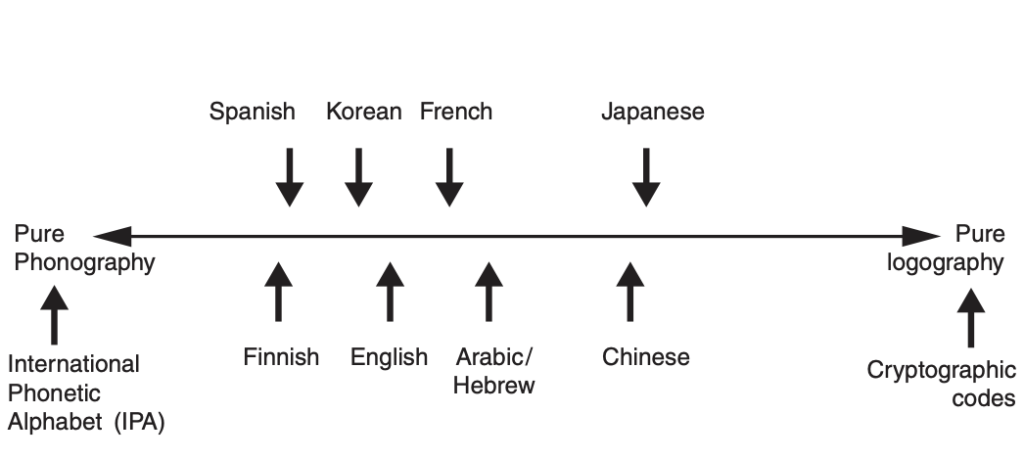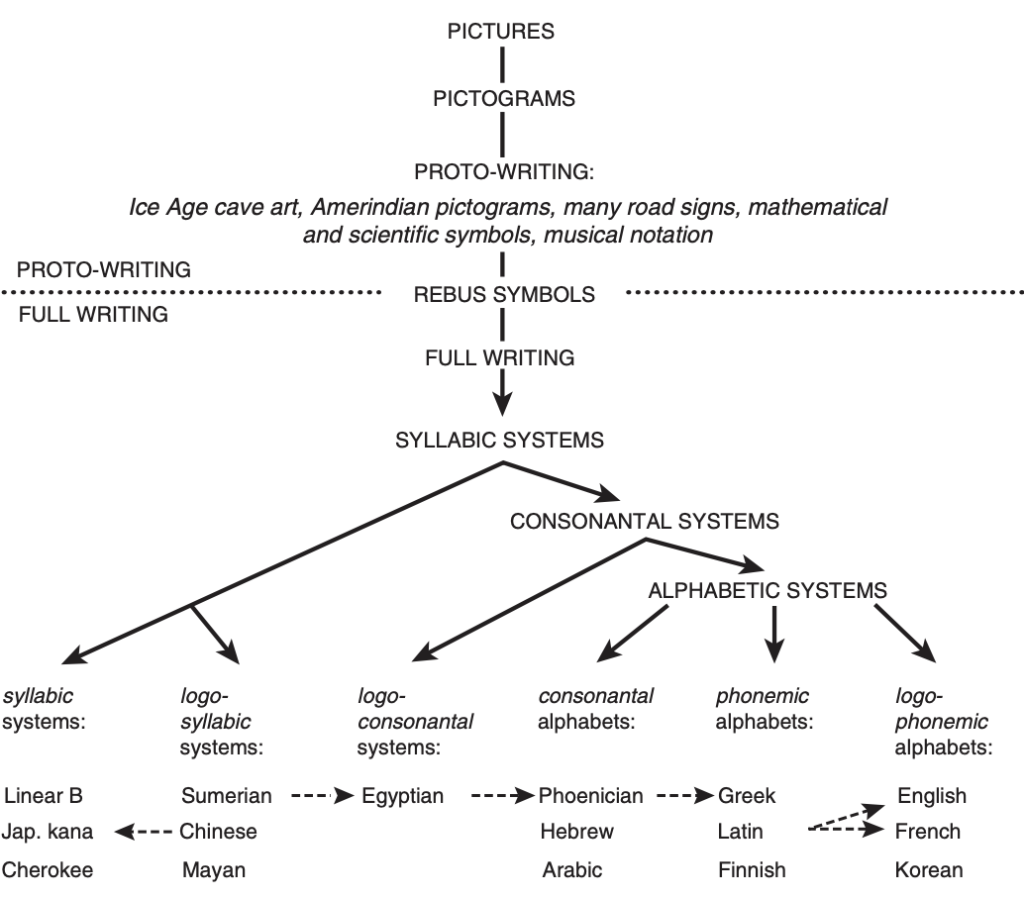Writing seems to have it’s origins in around 4000 BC.
Several authors claim as writing signs dating from as early as 20 000 BC. But, for this context, we consider everything we are not sure of being a full writing system as proto-writing (Robinson, 2009).
Writing is a “system of graphic symbols that can be used to convey any and all thought [or language]” (DeFrancis, 1989). An important notion to establish from an early stage is that at any given point in history or culture several writing systems coexist. Writing & proto-writing. Alphabetic, phonetic, ideographic, logographic, and pictographic. Formal and informal handwriting. Epigraphic inscriptions, calligraphic records, typographic printing (more recently), graffiti, etc.
Token objects are one of the earliest forms of known records dating from 8000 BC. Its function has been speculated, but become rarer around 3000 BC [with the spread of writing systems]. And one can say they were also the earliest form of checksum records. Tally sticks are another form of early record-keeping that is usually associated with writing. But these should be contextualized in mathematics and financing records history. Not in writing history. Another type of record worth mentioning in this context is asemic writing, which we will also not focus on.
The earliest form of writing comes from Mesopotamia in around 3300 BC, while in Egypt it dates from around 3200 BC. In China the “oracle-bones” date from 1200 BC although there is proto-writing from 5000 BC. In India writing dates from 2500 BC, but Brahmi only seems to date from 250BC. In Europe, writing can be found in Crete from 1900 BC, although there are some signs of Creatan Hieroglyphs from around 2100 BC. And in Meso-America Olmec writing has been found in the gulf of Mexico from 900 BC.
Its earliest forms, the written symbols were basically pictures, or pictograms depicting animals, plants, body parts, or geography. Some were used in combination to depict concepts.
It is generally accepted that these pictographic scripts —such as the Chinese, Egyptian and Mesopotamian scripts— have slowly evolved into more abstract records. Eg. the Egyptian hieroglyphs (although remained) gave rise to an administrative Hieratic and later to a more current Demotic script. The latest Egyptian script is the religious Coptic script (last used around the 2nd century AD). To a point that in present-day alphabetic scripts, such as Latin alphabets, it is hard to see the pictographic origin of the characters [but it is there].
Full (alphabetic) writing owes its origin to the rebus principle —to convey meaning by the part or sound of the sign. These seem to have their first appearance in a small Canaanite lapis lazuli mining settlement (in present-day Afghanistan) where Egyptians and Sumerians lived, worked, and traded together around 3000 BC. This writing system eventually found its way to the Mediterranean coastal city of Byblos, where the Phoenecian “trading experts” adopted and further enhanced it.

Thus we have the following approximate dates of origin for full writing: Mesopotamia 3100 BC, Egypt 3100–3000 BC, India 2500 BC, Crete 1750 BC, China 1200 BC, Meso-America 900 BC.
Robinson, 2009, p. 20
Western world scripts
According to Hamilton (1918), the Latin alphabet is a small part of the “Hellenic” branch of the tree that has become the “western” world of scripts.
Phoenicians influenced and seem to may have been at the origin of several other scripts — although there is still no clear link between the early Canaanite inscriptions and Phoenicians. And the Phoenicians and the Greeks.
Phoenecian originated around the 12th century BC and disappeared roughly 200 years later after the Roman conquest of Carthage.
Etruscan was the main intermediary between cultures. They traded with Phoenicians and were responsible for transmitting the Greek culture to Latins until they were absorbed by Romans in the 1st century AD.

Making this long [5000 years] story short, it is possible to say that roughly 3 main writing systems are responsible for all of today’s writing systems.
Egyptian that eventually influenced Arabic and found its way to Ethiopian and Amharic script.
Phoenician went “westward” to influence Greeks, Etruscans, and eventually, Romans giving birth to the Latin script. It also remained in the middle-east region, evolving and giving birth to several scripts such as Hebrew. And moving slightly “southbound” to influence and give birth to the Arabic scripts. Finally, it is speculated that it may have moved “eastward” [through trading routes such as the silk road] and influence the birth of Indus scripts such as Brahmi. This influence is as far-reaching as the Tibetan or Mongolian scripts.
Chinese scripts originated in mainland China. Disseminated throughout the nearby nations such as Japan and Korea. Nevertheless, dialects and culture made them all different, despite sharing several pictographic (representational or radicals) and phonetic (rebus) or semantic (compositional) principles among them. Despite the “prestige” of the Chinese origins of this system, most if not all Asian nations sustain multiple writing systems, including a romanized (phonetic) version.
Hence, all languages and writing systems share some sort of common ground in the phonetic-pictographic axis.

In the end, there is no “pure” system. All scripts inherit influences from previous cultures and mix representational styles from phonetic and logographic nature.

References
DeFrancis, J. (1989). Visible speech: The diverse oneness of writing systems. University of Hawaii Press.
Hamilton, F. W. (1918). Books Before Typography: A primer of information about the invention of the alphabet and the history of book-making up to the invention of movable types. United Typothetae of America.
Robinson, A. (2009). Writing and script: a very short introduction (Vol. 208). Oxford University Press.
Published on 2021-03-06. Updated 2021-03-08.